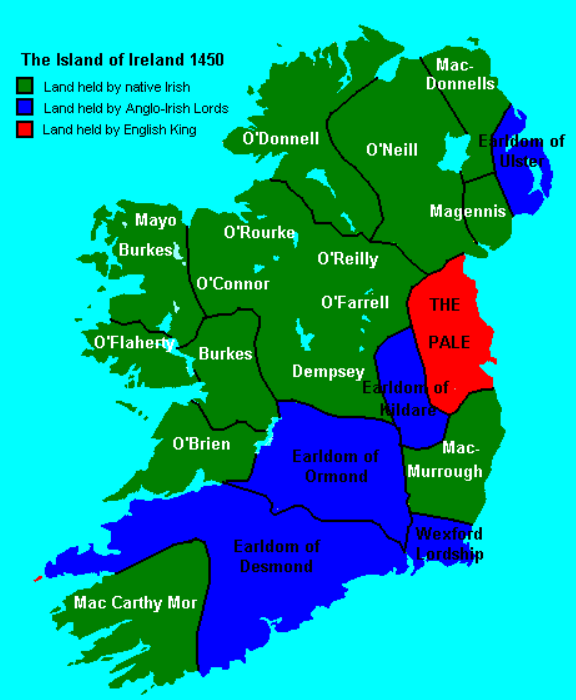Summary | Excerpt | Reviews | Beyond the Book | Read-Alikes | Genres & Themes | Author Bio

A Novel
by Jo HarkinThis article relates to The Pretender
 In Jo Harkin's new novel The Pretender, Lambert Simnel—a long-shot hopeful for the English throne—is taken to raise an army in the English Pale in Ireland, the last Tudor stronghold on the island. A small area encompassing the counties around Dublin, the Pale is intimately tied to the history of Ireland and the beginnings of the country's fraught relationship with its neighbors to the east.
In Jo Harkin's new novel The Pretender, Lambert Simnel—a long-shot hopeful for the English throne—is taken to raise an army in the English Pale in Ireland, the last Tudor stronghold on the island. A small area encompassing the counties around Dublin, the Pale is intimately tied to the history of Ireland and the beginnings of the country's fraught relationship with its neighbors to the east.
English encroachment onto the territory of Ireland began with the Anglo-Norman invasion in 1169, after Henry II had been given papal dispensation to bring the practices of the Irish church into line with Rome. Although the English forces quickly conquered much of the south and east of the island and set up the "Lordship of Ireland," large swathes of the north and west remained under the control of the Gaelic kings. The Anglo-Norman presence in the country peaked sometime around the mid 13th century; over the next two hundred years—distracted by the Hundred Years' War and the War of the Roses—the English drew back until their influence was concentrated in the "four obedient shires" around Dublin.
Although diminished in force, the English still took an interest in maintaining a foothold on Ireland both militarily and culturally. Laws were introduced banning marriage between English colonists and Irish natives, and the accusation of Irish blood could prove ruinous for those in public office. The use of the Irish language and the adoption of Irish customs—including Irish hairstyles like the "glib," something of a medieval mop top—were likewise prohibited among the English settlers. However, those measures didn't stop the gradual intrusion of Gaelic influences from the rest of the island. By the end of the 15th century, the English Lord Deputy of Ireland was ready to do away with the pretense that his title spoke to any real control beyond the four shires. In 1494, he passed an act of parliament ordering the construction of a defensive boundary around the English territory, naming this last small bridgehead in Ireland "the Pale."
The area took its name from pal, an Old French word for the stakes used to hold up a fence (and from which we get the modern word "pole"). The phrase "beyond the pale," meaning behavior outside the accepted norms of civilized society, likely comes from this same notion of a boundary, although there is no evidence for the frequent claim that the expression derives specifically from the Irish Pale. To the English in the 15thcentury, the idea of an overseas "Pale" within their control was already a familiar one: the Pale of Calais in northern France had been established during the Hundred Years' War and was invaluable as an entry point to the continent's trade routes. For much of the Middle Ages, this Pale on the continent took precedence.
By the mid 1500s, however, with the Tudor dynasty firmly established and the threat of civil war diminished, England was once again ready to turn its attention westward. In 1542, Henry VIII did away with the Lordship established four centuries earlier and proclaimed himself King of Ireland. The move was more than symbolic: English policy shifted from decentralization to direct control. Over the next decades the Tudors embarked on a conquest beyond the Pale, conquering Irish that had never previously fallen into English hands. By the turn of the 17th century, the notion of English authority concentrated around Dublin was a distant memory. That authority, however uneasily, now blanketed the island as a whole. The Pale became a symbolic boundary line: a reminder of a time when the affairs of the Irish people were less dominated by their English neighbors.
Map of Ireland c. 1450, with The Pale (colored red), courtesy of The Ireland Story
Filed under Places, Cultures & Identities
![]() This article relates to The Pretender.
It first ran in the April 23, 2025
issue of BookBrowse Recommends.
This article relates to The Pretender.
It first ran in the April 23, 2025
issue of BookBrowse Recommends.
A library is a temple unabridged with priceless treasure...
Click Here to find out who said this, as well as discovering other famous literary quotes!
Your guide toexceptional books
BookBrowse seeks out and recommends the best in contemporary fiction and nonfiction—books that not only engage and entertain but also deepen our understanding of ourselves and the world around us.